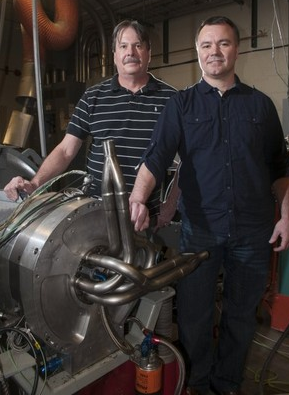Inventors overcome hurdles in driving engine to market

University of Tennessee engineering professor David Irick, left, and Power Source Technologies CEO Bart Watkins with the Legacy Engine. Photo: J. Miles Cary
Courtesy of Knoxvillebiz.com by Kay Brookshire: Bart Watkins’ quest to bring to reality his grandfather’s idea for a lighter, simpler rotary engine has achieved several milestones and found a potential new application that could get the invention to market more quickly.
“As far as getting to production, we are at a point where engineering can solve our problems, as opposed to having to innovate,” says Watkins, chairman and CEO of Power Source Technologies Inc.
Watkins and his team are ready to build a prototype of the engine that could power tractor-trailer trucks, generators and vehicles his grandfather hadn’t imagined — unmanned aerial vehicles, commonly known as drones.
With the aid of a $500,000 U.S. Department of Energy grant managed by the National Transportation Research Center Inc., the company solved two technical challenges in 2011 and 2012.
“I think it (the engine) has a lot of potential, either in the remotely piloted vehicle area — they have a lot of support from folks in that business — or the commercial vehicle business,” says Joe Petrolino, president of the center that seeks to commercialize transportation technologies, particularly those developed at the Oak Ridge National Laboratory, University of Tennessee and other universities.
“If they can pull it off, particularly in the heavy truck market, you have a next-generation engine, which will have greater fuel economy and capability than what you have now,” Petrolino adds.
U.S. Rep. Jimmy Duncan’s office referred Watkins to the nonprofit center that also helped PST with a small U.S. Department of Transportation grant and a state grant.
“They have been very methodical,” Petrolino says of PST’s leaders. “They take everything step by step and go through a very detailed and rigorous process. They’ve got a good team of people.”
Watkins’ company recently applied for a Small Business Innovation Research grant from the U.S. Department of Defense for the development phase, a move resulting from Watkins’ attendance at an aerospace executives’ conference. There he met the CEO of Aerojet, a California-based aerospace and defense contractor. Aerojet helped PST apply for the highly competitive grant encouraging high-tech R&D that could lead to commercialization.
Besides heading PST, Watkins manages the family business, Liz-Beth & Co., a West Knoxville fine art gallery. A model of the engine’s rotary components sits on his desk there, looking as much like a sculpture as an engine.
Watkins’ team originally targeted the Legacy engine for tractor-trailer trucks, which would require a significant investment for production. Seeking to move to production more quickly, they began looking at different uses for the engine in smaller markets, Watkins explains.
Watkins estimates that, with development funds, the company could have a generator or drone engine ready for beta testing in three years. An engine for trucks could take five years, due to regulatory and emission compliance issues. A large company that operates a trucking fleet has an agreement with PST to provide vehicles to test the new engine at that phase of development, Watkins says.
The next step will be developing a stand-alone engine, complete with housing for the engine that includes cooling, allowing the tech team to test the engine for more than a few seconds.
Watkins has five patents and two more pending in the United States, as well as patents in several countries. He lists himself, his grandfather, and Larry Hendrix, a retired engineer and PST vice president, as co-inventors. David Irick, faculty member in the Mechanical Engineering Department at the University of Tennessee, is PST’s chief technical officer, responsible for testing the engine.
Ernie Watkins, Bart’s grandfather, was a mechanical engineer on medical leave from his job at the Y-12 plant in Oak Ridge in 1968 when he began sketching ideas for a smaller, less complicated, more efficient engine, and showed them to his then 16-year-old grandson, Bart.
“It really just never left my mind. I tinkered around with it for years and years,” Watkins says. His grandfather died in 1994, knowing that Watkins was committed to the engine. “He always liked the fact that someone took one of his inventions and pushed it forward.”
In the 10 years since Watkins started PST, the company has raised and invested about $2.5 million in private funds, with grants bringing the investment to more than $3 million. Networking has helped the company pursue a new engine technology on a very small budget, Watkins says.
“It’s very clear to everyone who invests with us that we know how to stretch a dime,” he says.
Category: Engines & Drivetrains, General Update










